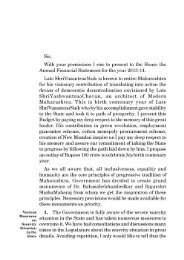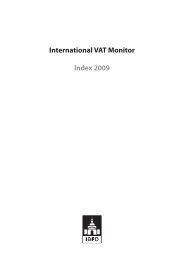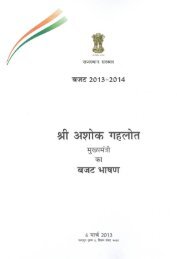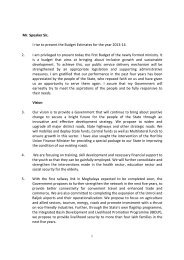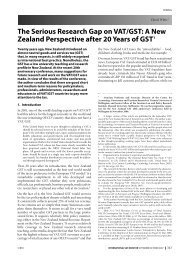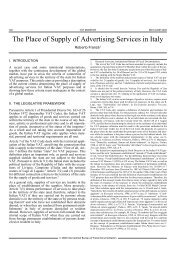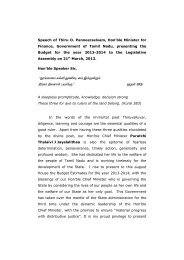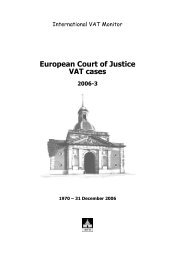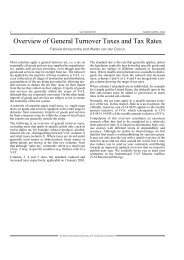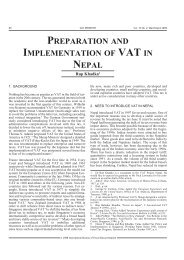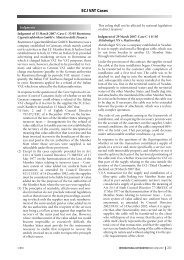The Rise of VAT in Africa – Impact and Challenges - empcom.gov.in
The Rise of VAT in Africa – Impact and Challenges - empcom.gov.in
The Rise of VAT in Africa – Impact and Challenges - empcom.gov.in
Create successful ePaper yourself
Turn your PDF publications into a flip-book with our unique Google optimized e-Paper software.
grammes developed <strong>in</strong> <strong>Africa</strong>: design<strong>in</strong>g an appropriate<br />
tax regime for small <strong>and</strong> micro bus<strong>in</strong>esses is a necessary<br />
step towards facilitat<strong>in</strong>g the modernization <strong>of</strong> the <strong>VAT</strong><br />
system <strong>and</strong> the adoption <strong>of</strong> a high registration threshold.<br />
<strong>The</strong> comparative study <strong>of</strong> the tax systems for small bus<strong>in</strong>esses<br />
shows a great diversity <strong>of</strong> the exist<strong>in</strong>g regimes,<br />
<strong>in</strong>clud<strong>in</strong>g: turnover taxes, patents, systems based on<br />
physical <strong>in</strong>dicators, taxes based on the bus<strong>in</strong>ess’ rental<br />
value, etc. 6 Discussion <strong>and</strong> the exchange <strong>of</strong> views on this<br />
topic are relatively new. <strong>The</strong> discussions dur<strong>in</strong>g the ITD<br />
conference confirm that there is not yet a credible guide<br />
to best practices. While an <strong>in</strong>-depth evaluation <strong>of</strong> the<br />
exist<strong>in</strong>g regimes is needed, those recently developed <strong>in</strong><br />
some countries should be given particular attention, for<br />
example, the tax regime for small bus<strong>in</strong>esses that was<br />
<strong>in</strong>troduced <strong>in</strong> Madagascar <strong>in</strong> 2008. 7<br />
4. Reform <strong>of</strong> Tax Adm<strong>in</strong>istration <strong>–</strong> Progress <strong>and</strong><br />
<strong>Challenges</strong><br />
4.1. <strong>Impact</strong> <strong>of</strong> <strong>VAT</strong> on tax adm<strong>in</strong>istration<br />
<strong>VAT</strong> is certa<strong>in</strong>ly the most important tax reform that has<br />
taken place <strong>in</strong> <strong>Africa</strong> <strong>in</strong> the past 20 years <strong>and</strong> it is not surpris<strong>in</strong>g<br />
that its <strong>in</strong>troduction has resulted <strong>in</strong> significant<br />
changes for most tax adm<strong>in</strong>istrations <strong>in</strong> this region. <strong>The</strong><br />
experts who question the appropriateness <strong>of</strong> <strong>VAT</strong> for<br />
develop<strong>in</strong>g countries sometimes claim that similar<br />
changes could have been made under the previous tax<br />
systems, <strong>in</strong>clud<strong>in</strong>g the old turnover taxes. To a large<br />
extent, these views reflect a lack <strong>of</strong> experience with the<br />
actual situation <strong>of</strong> the tax <strong>and</strong> customs adm<strong>in</strong>istrations<br />
<strong>in</strong> <strong>Africa</strong>.<br />
<strong>The</strong> collection procedures for <strong>in</strong>come tax that were <strong>in</strong><br />
place prior to the <strong>in</strong>troduction <strong>of</strong> <strong>VAT</strong> were primarily<br />
based on negotiations between tax <strong>of</strong>ficers <strong>and</strong> taxpayers.<br />
8 <strong>The</strong>se procedures were particularly <strong>in</strong>effective <strong>and</strong><br />
time consum<strong>in</strong>g. <strong>The</strong>y also provided significant opportunities<br />
for corruption. Similarly, the old turnover taxes<br />
were particularly complex <strong>and</strong> difficult to adm<strong>in</strong>ister. In<br />
several countries, they were supplemented by specific<br />
excise taxes on numerous items (sometimes more than<br />
20, such as gold, tea, sugar, cement, soap, etc). <strong>The</strong> adm<strong>in</strong>istration<br />
<strong>of</strong> these taxes was commonly based on physical<br />
controls similar to those used by the customs adm<strong>in</strong>istration.<br />
<strong>The</strong>se controls provided opportunities for multiple<br />
visits to the taxpayer’s premises, which were frequently<br />
accompanied by harassment <strong>and</strong> corruption. All<br />
tax adm<strong>in</strong>istration specialists who have provided technical<br />
assistance <strong>in</strong> <strong>Africa</strong>n countries before the <strong>in</strong>troduction<br />
<strong>of</strong> <strong>VAT</strong> can confirm that it was impossible to<br />
develop a sound tax adm<strong>in</strong>istration modernization<br />
strategy <strong>in</strong> such a context.<br />
Modernization <strong>of</strong> the tax adm<strong>in</strong>istration has <strong>of</strong>ten<br />
started with develop<strong>in</strong>g more effective <strong>and</strong> transparent<br />
collection methods for <strong>VAT</strong>. It has also frequently<br />
<strong>in</strong>volved a fundamental change <strong>in</strong> the organizational<br />
structure <strong>of</strong> the tax adm<strong>in</strong>istration, especially <strong>in</strong>tegration<br />
<strong>of</strong> functions that were previously fragmented<br />
among several agencies. Another component <strong>of</strong> the<br />
Articles<br />
modernization, which has also been significantly <strong>in</strong>fluenced<br />
by the “structur<strong>in</strong>g effect” <strong>of</strong> <strong>VAT</strong>, is the development<br />
<strong>of</strong> the concept <strong>of</strong> “segmentation” <strong>of</strong> taxpayers. This<br />
concept takes <strong>in</strong>to account the characteristics <strong>of</strong> the various<br />
categories <strong>of</strong> taxpayers, <strong>in</strong> order to adapt the compliance<br />
programmes <strong>and</strong> the network <strong>of</strong> local <strong>of</strong>fices to<br />
the need <strong>of</strong> the taxpayers for specific services, <strong>and</strong> to the<br />
different types <strong>of</strong> risks <strong>of</strong> non-compliance (see below). 9<br />
When <strong>and</strong> how have these reforms started <strong>in</strong> <strong>Africa</strong>? In<br />
several countries, substantial procedural <strong>and</strong> organizational<br />
reforms were <strong>in</strong>itiated dur<strong>in</strong>g the preparatory<br />
stage <strong>of</strong> the <strong>in</strong>troduction <strong>of</strong> <strong>VAT</strong>. This was, for example,<br />
the case regard<strong>in</strong>g the transfer <strong>of</strong> the collection function<br />
from the Treasury to the tax adm<strong>in</strong>istration <strong>and</strong> the<br />
establishment <strong>of</strong> the first large-taxpayers <strong>of</strong>fices to facilitate<br />
the <strong>in</strong>troduction <strong>of</strong> <strong>VAT</strong> <strong>in</strong> francophone <strong>Africa</strong> (for<br />
example, <strong>in</strong> Ben<strong>in</strong> <strong>in</strong> 1990 <strong>and</strong> <strong>in</strong> Togo <strong>in</strong> 199 ). To some<br />
extent, the creation <strong>of</strong> semi-autonomous revenue agencies<br />
(the “revenue authorities”) <strong>in</strong> anglophone <strong>Africa</strong> <strong>in</strong><br />
the 1990s was also part <strong>of</strong> the plans that were developed<br />
for the <strong>in</strong>troduction <strong>of</strong> <strong>VAT</strong> (for example <strong>in</strong> Tanzania,<br />
Ug<strong>and</strong>a <strong>and</strong> Zambia).<br />
Moreover, significant steps, such as the development <strong>of</strong><br />
taxpayer identification number systems, new fil<strong>in</strong>g <strong>and</strong><br />
payment methods, <strong>and</strong> new education <strong>and</strong> <strong>in</strong>formation<br />
programmes, were also developed <strong>in</strong> several countries<br />
dur<strong>in</strong>g the preparations for the <strong>in</strong>troduction <strong>of</strong> <strong>VAT</strong>, on<br />
the basis <strong>of</strong> the available guides <strong>of</strong> best practices. 0 However,<br />
<strong>in</strong> most <strong>Africa</strong>n countries, <strong>in</strong>clud<strong>in</strong>g those where<br />
prelim<strong>in</strong>ary steps had been taken prior to the <strong>in</strong>troduction<br />
<strong>of</strong> <strong>VAT</strong> or as part <strong>of</strong> the preparatory process, the<br />
most fundamental reforms <strong>of</strong> the tax adm<strong>in</strong>istration<br />
were made after this <strong>in</strong>troduction.<br />
4.2. Modernization <strong>of</strong> the method <strong>of</strong> taxation<br />
<strong>VAT</strong> is basically a self-assessed, account-based tax. Its<br />
<strong>in</strong>troduction has led to significant changes <strong>in</strong> the<br />
method <strong>of</strong> taxation. <strong>The</strong> fil<strong>in</strong>g <strong>and</strong> payment regimes that<br />
6. Bod<strong>in</strong> <strong>and</strong> Koukpaizan (note 12), <strong>and</strong> Marquez, Bareix <strong>and</strong> Villela, Recommendations<br />
<strong>and</strong> Best Practices on Taxation <strong>of</strong> SMEs <strong>in</strong> Lat<strong>in</strong> America, (Inter-<br />
American Development Bank, 200 ).<br />
7. This regime was developed for small <strong>and</strong> micro bus<strong>in</strong>esses with a<br />
turnover below the <strong>VAT</strong> registration threshold (approximately USD 100,000).<br />
Small bus<strong>in</strong>esses, which are def<strong>in</strong>ed as those with a turnover between USD<br />
10,000 <strong>and</strong> the <strong>VAT</strong> threshold, are subject to a simplified (cash flow) <strong>in</strong>come<br />
tax. Micro bus<strong>in</strong>esses, which are def<strong>in</strong>ed as those with a turnover below USD<br />
10,000, are subject to a presumptive tax based on the turnover. A similar<br />
regime was also developed <strong>in</strong> Egypt <strong>in</strong> 2006, but it is unclear if a firm decision<br />
has been made to launch it.<br />
8. In anglophone <strong>Africa</strong>, these procedures were based on “adm<strong>in</strong>istrative<br />
assessment.” <strong>The</strong>y provided for the verification <strong>of</strong> all returns prior to f<strong>in</strong>alization<br />
<strong>of</strong> the assessment <strong>and</strong> payment <strong>of</strong> the <strong>in</strong>come tax due (<strong>of</strong>ten several years<br />
after the return had been submitted). A similar concept (enrôlement) was also<br />
used <strong>in</strong> several francophone countries, where the taxation process was further<br />
complicated by the fragmentation <strong>of</strong> the assessment <strong>and</strong> collection functions<br />
between two directorates report<strong>in</strong>g separately to the M<strong>in</strong>ister <strong>of</strong> F<strong>in</strong>ance.<br />
9. Taxpayer segmentation is an application <strong>of</strong> a basic market<strong>in</strong>g concept<br />
(market segmentation) to identify the unique characteristics <strong>of</strong> different<br />
groups <strong>of</strong> clients <strong>and</strong> design a market<strong>in</strong>g strategy that is based on these characteristics.<br />
<strong>The</strong>oretically, this concept could have been developed from a<br />
review <strong>of</strong> <strong>in</strong>come tax data. However, these data were particularly poor <strong>and</strong><br />
<strong>in</strong>accurate <strong>in</strong> most <strong>Africa</strong>n countries.<br />
0. In particular, <strong>VAT</strong>: Adm<strong>in</strong>istrative <strong>and</strong> Policy Issues (IMF, 1991).<br />
© IBFD INTERNATIONAL <strong>VAT</strong> MONITOR MAY/JUNE 2009<br />
18



